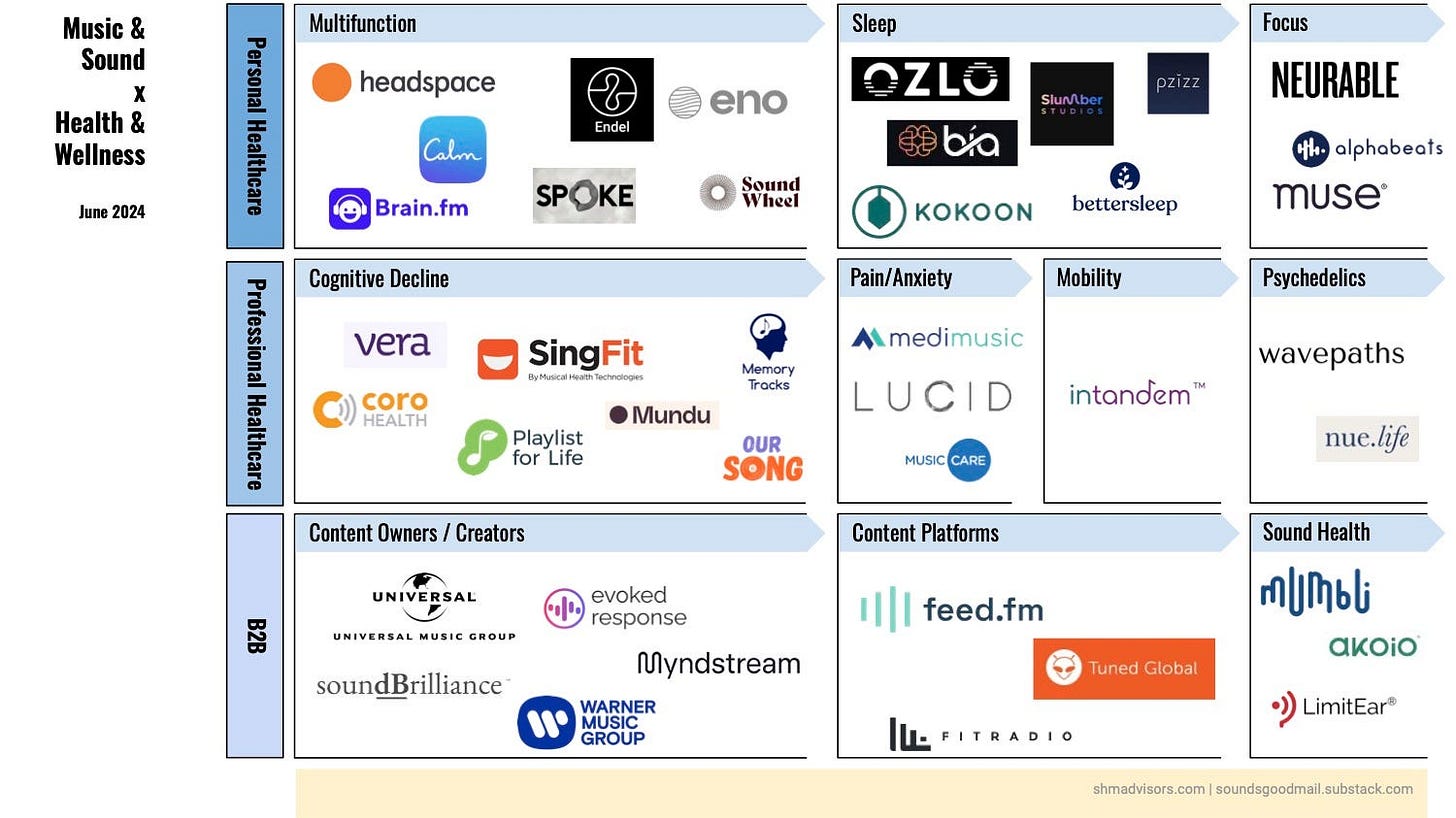Sounds Good! #37: Music x Health Market Map, Apple, MedRhythms, Men's Health, The Conversation, Dr Michael Mosley, Tonic Music, Azo Sensors, Musicology Now
Tracking developments at the intersection of music and health
Hello!
Welcome to issue #37 of Sounds Good! — your regular roundup of happenings at the intersection of music, health and technology:
Who are the key companies and organisations driving innovation in music and health? I try to answer this question in the “Music & Sound x Health & Wellness” market map. This is very much a ‘version 1’, and I would welcome any feedback on what could be improved in future iterations.
The Apple Hearing Study, conducted by the University of Michigan, has released preliminary data from one of the largest surveys on tinnitus. The study reviewed over 160,000 participants, revealing that 77.6% have experienced tinnitus, with 15% experiencing it daily. Notably, those aged 55+ are three times more likely to experience daily tinnitus compared to younger individuals. Participants reported using noise machines, nature sounds, and meditation for management. The article also profiles Apple’s apps which can help understand exposure to environmental noise, reduce loud audio, and reduce exposure through noise cancelling technology.
“97% of the human population, regardless of age, culture, ability or disability, all respond to music objectively, and there is no other stimulus on earth that engages our brain like music does”. Brian Harris of MedRhythms provides this concluding comment at the end of this beautiful short video on the power of Neuro Music Therapy, which is helping people regain mobility, and be able to utter simple but important phrases - such as “I love you”.
Men’s Health magazine asks, “Can Science Help You Build the Perfect Gym Playlist?”, and interviews Spotify’s Ronny Ho about the streaming platform’s ‘Beast Mode’ playlist (the 11th most popular Spotify playlist with 10.7m likes at the time of writing). ‘Personalization’ is a key theme which is underscored by further commentary from sports psychologist Costas Karageorghis, who talks about the potential for gym playlists to be tailored according to inputs from sensors which track how a gym class is working out (Karageorghis’ project with David Berezan ‘Sound Runner’ was featured in Sounds Good! #35). Finally, Antony Stewart’s work on the BeatFit app is explained, which uses ‘music differentiation’ to curate a soundtrack that matches the structure of an individual’s workout.
The discussion around AI within the music industry continues to be deafening, with the rise of platforms such as Suno and Udio, and questions around how the Large Language Models (LLMs) that power these platforms have been trained. I’ve been in a few conversations recently along the lines of: if these platforms can create ‘perfect’ recordings now, does anyone need to play musical instruments anymore? This article in The Conversation makes a solid argument for the case of ‘yes’: “The health benefits are overwhelming... The neurological benefits are also astounding, with no other activity lighting up as many parts of the brain. No matter how good computers get at making music, active music engagement will always remain an important way to regulate our mood and nervous system.” It goes on to make an analogy with travelling up a mountain: “Although we now have chair lifts, gondolas, funiculars, helicopters, planes, trains and cars to take people to the top, people still love climbing mountains for the mental and physical benefits.”
On the benefits of playing music, the UK news headlines this month featured the disappearance and passing of medical journalist Dr Michael Mosley. Mosley was well known for his BBC radio show ‘Just One Thing’, in which each episode explored a single action that someone could take to improve their health. An episode earlier this year suggested the ‘one thing’ is to ‘play an instrument’.
Tonic Music has launched ‘Tonic Futures’, a program aimed at supporting the mental health of young music professionals aged 18-25 - a group which experiences particularly high levels of anxiety and depression according to research by the charity. The program offers therapeutic sessions, peer groups, and workshops, partnering initially with Beacons Cymru, BIMM London, and Roundhouse to support 63 individuals over a year.
As noted in previous issues of this newsletter, the growth in headphones with biosensors continues at a strong pace. This article in Azo Sensors (the ‘leading online publication for the Sensors community’, according to its website), takes a step back and looks at the evolution from basic pedometers to in-ear EEG sensors. It notes the benefits of in-ear sensors being closer to the brain and providing a more stable environment for biomarker measurement than devices that are worn on the wrist.
This thoughtful, critical piece passed me by earlier this year, but is a well-researched essay with a treasure-trove of interesting links. “Welcome to the Sound Wellness Revolution” by Ryan Blakely (a Musicology Ph.D. candidate at the Eastman School of Music) in Musicology Now highlights concerns around ‘the commodification of passive listening’ and ‘exploiting self-care for profit’. The functional music app Endel is the centrepiece for Blakely’s critique, though his observations around influencing mood and behaviour through music are more broadly applicable - and ends with this call to action and question: “[W]e should critically examine the ways that digital platforms are profiting from passive listening practices and mediating our relationship to sound and self. Because if this is the “sound wellness revolution,” who do you want leading the charge?”
Thanks for reading and supporting Sounds Good!
Please do share with anyone you think might find this interesting, or reply with comments/suggestions/feedback.
Cheers!
Rob




